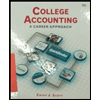
1.
Introduction: Financial statements are the position statement of the business that provide information related to the
The
2.
Introduction: Financial statements are the position statement of the business that provide information related to the profit earned or loss incurred during the period as well as the assets and liabilities a business owns at the end of the period. It helps in making future business decisions.
The
3.
Introduction: Financial statements are the position statement of the business that provide information related to the profit earned or loss incurred during the period as well as the assets and liabilities a business owns at the end of the period. It helps in making future business decisions.
The adjusted
4.
Introduction: Financial statements are the position statement of the business that provide information related to the profit earned or loss incurred during the period as well as the assets and liabilities a business owns at the end of the period. It helps in making future business decisions.
The income statement.
5.
Introduction: Financial statements are the position statement of the business that provide information related to the profit earned or loss incurred during the period as well as the assets and liabilities a business owns at the end of the period. It helps in making future business decisions.
The classified
6.
Introduction: Financial statements are the position statement of the business that provide information related to the profit earned or loss incurred during the period as well as the assets and liabilities a business owns at the end of the period. It helps in making future business decisions.
The closing entries.
7.
Introduction: Financial statements are the position statement of the business that provide information related to the profit earned or loss incurred during the period as well as the assets and liabilities a business own at the end of the period. It helps in making future business decisions.
The required analysis.
Want to see the full answer?
Check out a sample textbook solution
Chapter 8 Solutions
INTERMEDIATE ACCOUNTING ACCESS 540 DAY
- I am trying to find the accurate solution to this general accounting problem with appropriate explanations.arrow_forwardAccounting problemarrow_forwardTrent Manufacturing Company produces and sells 95,000 units of a single product. Variable costs total $285,000 and fixed costs total $390,000. If each unit is sold for $11, what markup percentage is the company using?arrow_forward
- Davis Company reported an increase of $350,000 in its accounts receivable during the year 2023. The company's statement of cash flows for 2023 reported $980,000 of cash received from customers. What amount of net sales must Davis have recorded in 2023?arrow_forwardGiven the solution and accounting questionarrow_forwardSalem Enterprises reports its accounts receivable on the balance sheet. The gross receivable balance is $78,000, and the allowance for uncollectible accounts is estimated at 12% of gross receivables. At what amount will accounts receivable be reported on the balance sheet?arrow_forward
 College Accounting (Book Only): A Career ApproachAccountingISBN:9781305084087Author:Cathy J. ScottPublisher:Cengage Learning
College Accounting (Book Only): A Career ApproachAccountingISBN:9781305084087Author:Cathy J. ScottPublisher:Cengage Learning College Accounting (Book Only): A Career ApproachAccountingISBN:9781337280570Author:Scott, Cathy J.Publisher:South-Western College Pub
College Accounting (Book Only): A Career ApproachAccountingISBN:9781337280570Author:Scott, Cathy J.Publisher:South-Western College Pub Financial And Managerial AccountingAccountingISBN:9781337902663Author:WARREN, Carl S.Publisher:Cengage Learning,
Financial And Managerial AccountingAccountingISBN:9781337902663Author:WARREN, Carl S.Publisher:Cengage Learning, Financial AccountingAccountingISBN:9781337272124Author:Carl Warren, James M. Reeve, Jonathan DuchacPublisher:Cengage Learning
Financial AccountingAccountingISBN:9781337272124Author:Carl Warren, James M. Reeve, Jonathan DuchacPublisher:Cengage Learning College Accounting, Chapters 1-27AccountingISBN:9781337794756Author:HEINTZ, James A.Publisher:Cengage Learning,Principles of Accounting Volume 1AccountingISBN:9781947172685Author:OpenStaxPublisher:OpenStax College
College Accounting, Chapters 1-27AccountingISBN:9781337794756Author:HEINTZ, James A.Publisher:Cengage Learning,Principles of Accounting Volume 1AccountingISBN:9781947172685Author:OpenStaxPublisher:OpenStax College





